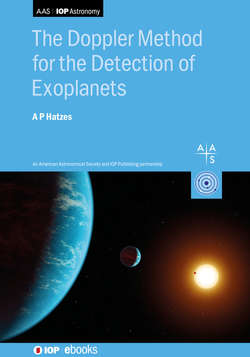Читать книгу The Doppler Method for the Detection of Exoplanets - Professor Artie Hatzes - Страница 42
На сайте Литреса книга снята с продажи.
3.1.1 Wavelength Coverage
ОглавлениеEvery spectral line gives you a Doppler measurement of the star with a certain error. Use a second line and your measurement error should decrease by the square root of two. Indeed, a simple simulation using spectral lines that all have the same strength confirms that if you achieve an RV error of σ for a single line, the total RV error decreases by σRV = σ(N), where N is the number of spectral lines (left panel of Figure 3.1). So naively, if we have a wavelength coverage of Δλ (not to be confused with spectral resolution, δλ) then we expect the RV error to scale as
σRV∝(Δλ)−0.5.(3.1)
Figure 3.1. (Left) Simulations (points) showing the normalized RV error σRV as a function of the number of spectral lines, Nlines, used in the RV measurement. The fit (line) shows that σRV∝ Nlines−0.5. (Right) The normalized RV uncertainty as a function of wavelength coverage for real data using the spectrum of a Sun-like star. The line represents a fit with σRV∝ Nlines−0.55.
Reality is a bit more complicated. The right panel of Figure 3.1 shows the behavior for real RV measurements on a solar-type star taken with the Tautenburg Coudé Echelle spectrograph (TCES). The method employed was the iodine absorption cell method, which will be covered in more detail in Chapters 4 and 6. The RV was calculated using an increasingly larger wavelength region.
The value of σRV indeed decreases with wavelength coverage, Δλ, but for a short wavelength coverage, it is markedly worse than the predicted behavior. However, it quickly falls in line with the predicted behavior. Beyond a wavelength coverage of about 1000 Å, the measurement error is flat, that is, increasing the wavelength coverage results in no substantial reduction in the measurement error. A fit to the data results in σ∝(Δλ)−0.55, close to the theoretical expectation.
There are three reasons for these deviations with the Δλ−0.5 law in Figure 3.1. First, an increase in wavelength coverage is not always followed by an increase in the number of useful spectral lines for a Doppler measurement. Depending on the effective temperature of the star, there can be spectral regions where the number density of lines is sparse. This is especially true of early-type stars. Furthermore, not all spectral lines have the same strength, and as we shall shortly see, this will affect the RV precision.
Second, once your wavelength coverage extends beyond about 6000 Å, telluric lines start to become prevalent (see Chapter 12). These features are not tied to the Doppler motion of the star, and they only serve to decrease the RV error precision.
Finally, as we shall soon see, the molecular iodine lines that were used to compute the relative RV shifts in Figure 3.1 become weak beyond about 5800 Å, and this results in a degradation of the RV precision. This, along with the presence of telluric lines, largely explains the flattening of the RV precision.
In practice, when performing precise RV measurements on a star, it is useful to explore how the measurement error behaves as one uses various spectral regions for the Doppler calculation. It is best to avoid those regions where there is no noticeable improvement in the error, or at least weight these accordingly. However, when performing RV measurements for solar-type stars in the optical region, we can expect σRV∝(Δλ)−0.5.
